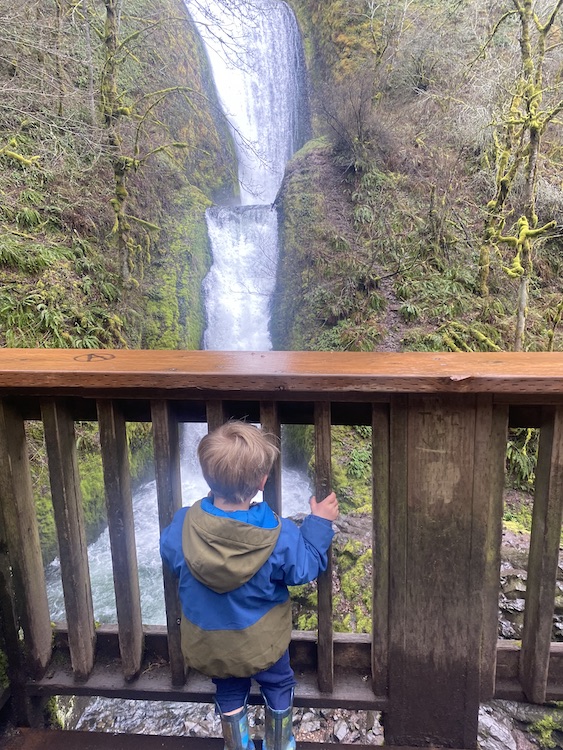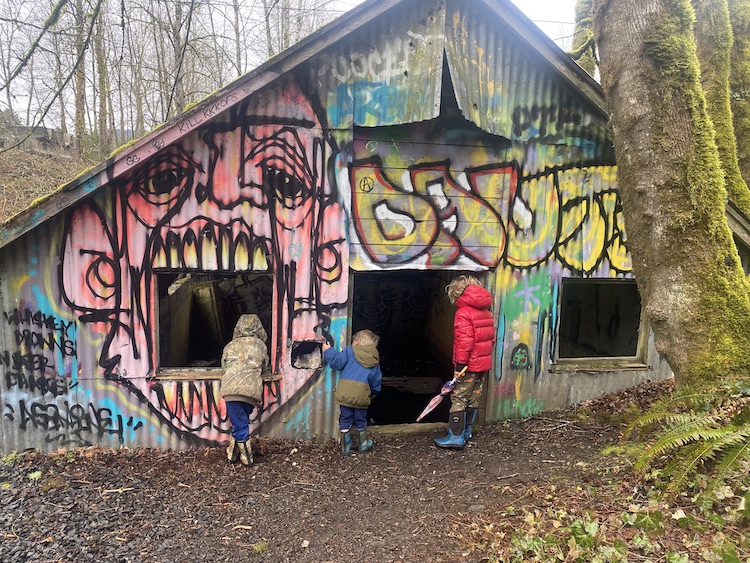
The days are getting shorter, and frost gilds the trees in the morning. It is the season of cozy sweaters, warm drinks, holidays and … waterfalls. While the idea of hiking with kids in cold weather might seem daunting, remind yourself that there is really no such thing as bad weather, only different kinds of good weather. So don’t be afraid to take your kids outside in rain, wind or snow. It will make them more resilient and teach them to appreciate the uniqueness of each season.
The best time to visit waterfalls in Oregon is from mid-fall through late spring, when snowmelt is at its peak. It’s best to avoid burned areas in the winter since burned vegetation can create loose soil and debris, making trails susceptible to erosion and landslides.
One of my favorite winter waterfall hikes is Bridal Veil Falls in the Columbia River Gorge. In fact, the first time I ever visited Bridal Veil was in the winter with our nature group. There were a few inches of snow on the ground and the kids had fun making snowballs and pulling the ice off leaves.
From the parking lot there are two short, easy hikes. There is the Overlook Trail which is a ½-mile paved loop. It takes you to beautiful, fenced lookouts of the Columbia River and rock formations such as Beacon Rock, Hamilton Mountain and Archer Mountain. This flat, easy loop is perfect for young hikers. Interpretive signs describe the wildflowers that grow in this area if you come back to visit in the springtime.
The Bridal Veil Falls Trail begins near the restrooms, and it is less than 1 mile round trip. Although it is not stroller- or wheelchair-friendly, this trail doesn’t have the steep and dangerous drop-offs characteristic of many Columbia Gorge waterfalls. There is a brief paved section, and then the road turns to dirt and gravel. The trail leads you downhill along a rock wall. After crossing a footbridge, there’s a series of stairs that lead to a bridge over Bridal Veil Creek. From here you get your first view of the waterfall. To get a closer look, turn right at the fork and walk a short distance to a wooden viewing platform.

If you take the left fork on the path, the trail takes you to an old mill site. Bridal Veil is a ghost town; there was once a bustling community in this area in the 1880s established mainly to harvest trees on Larch Mountain. Hundreds of people worked at the mill until it stopped operating in 1988 due to environmental concerns. The last remaining structure in the waterfall area is a graffitied, corrugated iron shed (pictured above). Use caution if you choose to explore this area. (My middle son, Grady, spent most of our hike convincing his younger brother there were real ghosts at the abandoned iron shed.)
This short hike provides an excellent opportunity to engage in place-based learning. Place-based learning is an educational approach that emphasizes the importance of connecting learning to the local environment and community. Bridal Veil is a great spot to learn about the geology of waterfalls, waterfall types, the formation of the Columbia River Gorge, and the history of the ghost town. As parents, we can steward our children’s sense of wonder — and there’s no better place to do that this winter than Bridal Veil Falls.
If You Go
Bridal Veil Falls State Park is located near milepost 28 on the Historic Columbia River Scenic Highway and is accessed off I-84 at Exit 28. Travel west on the Historic Columbia River Highway about 3/4 of a mile to the entrance of Bridal Veil Falls State Park.
The parking lot is across the street from the Bridal Veil Lodge Bed & Breakfast and has a restroom. There is no parking fee.
- How to Forage for Fungi With Your Family - October 31, 2024
- Look Underwater at This Mt. Hood Area Hike - March 26, 2024
- Why You Should Hike to Bridal Veil Falls — Even in Winter! - December 12, 2023
